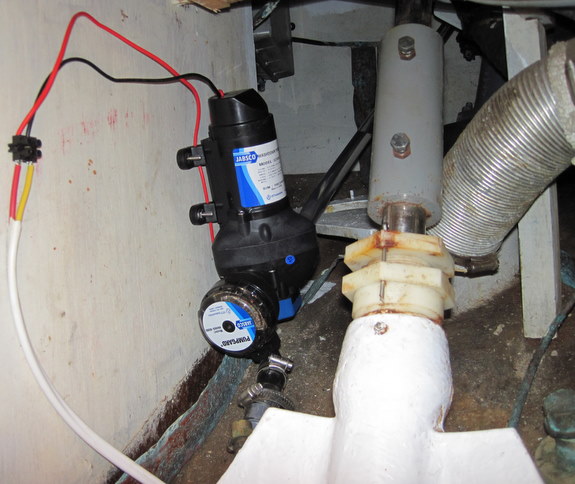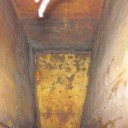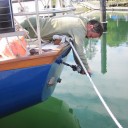Adding a Maintenance Bilge Pump

May 23rd, 2010 | by Marilyn | Published in Upgrades | 3 Comments
This posting is about good ideas and bad ideas. Or maybe I should say good ideas with bad and good implementations.
A lot of people say that it’s a good idea to have 3 (or maybe more) bilge pumps. At least 1 should be a manual pump that will work even if the batteries have failed. We’ve got that, it’s a nice old Henderson Mark III diaphragm pump, and yes it still works. Another should be an electric pump with high capacity for use if there is a serious water intake. We’re doing OK with our Rule 2000 (though it would probably be a good idea to add a higher capacity one for offshore). And the 3rd is a low capacity automatic pump that can act as the ‘daily’ maintenance pump to remove the expected water intake from the prop shaft lubrication, rain water from the keel-stepped mast, and so on. A little pump like this can have a small diameter outlet hose – maybe 1/2” ID – so the back drainage when the pump shuts off is little enough that the bilge is generally dry. Nice idea, we thought, since keeping a dry bilge is reportedly important to minimize the hull blistering problem. So, we decided to try this good idea. The problem was with our first implementation.
The bilge on Nicholson 38’s is about 3.5’ – and that measurement is just to the floor board, which is still below the waterline. If you want to pump to a thru-hull that is high enough to never be underwater (say, in the transom), it’s more like 7’ of head. That’s a lot of back pressure on a submerged pump in the bilge. We should have thought that through a little better before we purchased and installed a Shurflo 380 pump that theoretically can handle a 7.5’ head. Of course, anyone who has worked with submergible bilge pumps knows the reported specs have little to do with reality. In our case, with our fully charged batteries and a 1/2” ID hose that was 16’ long, the Shurflo 380 could only pump to about 4’ height. In other words, just barely out of the bilge and a far cry from the transom. This just wasn’t going to work!
This failure prompted me to start searching the forums to see what other people say. Lots are reporting how their small capacity bilge pumps work great with their 1/2” ID outlet hoses. So do Nic 38’s have extraordinarily deep bilges? I guess so! For those who did report problems, they implied that adding a vented loop would solve the issue. We never tried that because when we realized the theoretically head height was very close to what we needed in reality, we decided it wasn’t worth wasting more time on this approach.
I did get the idea from the forums to check into electric diaphragm pumps because they actually have the umpf to deal with a large head. Problem is, they can be pretty pricey. But after studying this, I decided the only difference between some diaphragm bilge pumps and deck washdown pumps is a pressure sensor. For example, check out the Flojet Quad series pumps. If I bought the washdown pump, we might be able to have it double as a maintenance bilge pump and the occasional-use washdown pump (you know, for when Van guts a fish on the back deck and we need to clean up the mess). No, we don’t intend to fill the bilge with water if we want to use it as a washdown pump!! As-built Nic 38’s have a sink in the aft cabin that has a drain thru-hull right by the rudder post. Rainshadow no longer has that sink, so the thru-hull is just capped. We had considered glassing that closed at the next haulout, but now we’re thinking of adding a good seacock and potentially hook up our new maintenance bilge pump so that it can either pump from the bilge out the transom, or pump from that thru-hull and out to a washdown hose.
But I’m getting ahead of myself here. Let me go back to what we finally ended up doing (editor note 2016 – and see the comments at the bottom to learn how we changed this approach in time):
1) We purchased a Jabsco PAR-Max 3 washdown pump, because it was on super sale for only $90. That’s a great price for a diaphragm pump that theoretically can dry prime to 6-10’, and pump a further 10-15’ (depends on which spec you read, but all are good enough for our application). We’re using this as our maintenance bilge pump.
2) We installed this pump adjacent to the rudder post on the interior starboard side of the cabinet. (see photo above). It comes with an inline strainer, which we mounted on the pump intake so it’s easy to view and clean. In the bilge at the inlet hose start, we added an ~8” capped PVC tube riddled with drilled holes to act as a large particle strainer, and a weight to hold down the tubing. (We used cheap nasty 1/2” ID tygon tubing for this inlet hose, which was a mistake, but it does fit through the limber hole to get from the bilge to the rudder post area).
3) We’re learning (the hard way) what makes horrible hose, and what makes good hose. For the pump outlet hose, picked up some great Trident XHD hose, suitable for below the waterline with good flexibility.
4) We routed that outlet hose to a new 3/4” stainless steel thru-hull in the transom (which meant Van drilled yet another hole in our hull! BTW – the transom is about 1/2” thick solid GRP). This should keep the bilge outlet above the waterline on all points of sail.
Note that as-built, the Nic 38 bilge outlet is on the starboard side near the center cockpit only a few inches above the at-rest waterline. We left the Rule 2000 high capacity pump and the manual pump plumbed to there, but we really question the merits of having a bilge outlet so close to the waterline on a sailboat (see photo below). We’ve heard from other Nic 38 owners who had serious water intake when sailing hard on a port tack, which would dump that bilge outlet deep in the water and potentially lead to siphoning, especially if an automatic bilge pump cycled while in that position! I have no proof that siphoning lead to their problems, but it sure seems plausible to me. This is something we intend to investigate. But back to the plot here…
5) Practical Sailor recommended the Water Witch as a reliable electronic bilge pump switch that benefits from having no moving parts. We wired that to the maintenance bilge pump, and positioned it about 1” off the bilge bottom so it will come on with a little water intake. The goal is to keep the bilge as dry as possible. Our testing suggests that maybe it should even be a little closer to the bilge floor. But we’ll watch that and decide later.
6) We remounted the submersible Rule 2000 high capacity pump about 6” from the bilge floor, and moved its mechanical float switch about 2” above the base of the pump. That means it should only come on if the Jabsco maintenance bilge pump gets overwhelmed due to a serious water problem. From our rough tests, we’re guessing that requires about 30-40 gallons in the bilge. It’s pretty surprising how big the Nic 38 bilge is! It has a huge volume under engine room. BTW – we mounted the pump and switch on a board, and then attached the board to the aft end of the engine room so the board is vertical in the bilge with the pump and switch at the low end. Removing the board pulls up the pump and switch at the same time so we can do yearly maintenance on them without having to struggle to reach the lower bilge.
7) We wired the original off-on-auto switch that was hidden under the Nav station to the maintenance pump, and we’ll leave that set on auto. We then added in the cockpit a second off-on-auto toggle switch for the Rule 2000 high capacity pump. We put this on the inboard side of the helm column in a place that we hope is highly visible because…
8 ) We (are going to) wire a LOUD alarm that will sound if the float switch for the high capacity pump detects water. If there is something like 40 gallons of water in the bilge, we really, really, 10-reallies want to know about it. This alarm will have its own on/off switch because the last thing we want in an emergency is a incessant screaming alarm.
We’ve had long discussions about which state we should leave the Rule 2000 off-on-auto switch. If that high capacity pump ever comes on, it means there is a serious leak that needs fixing. Just running the pump may keep the water at bay for a while, but only until the batteries are dead and then the boat will sink if the leak is not repaired. The question is – should the switch be ‘off’ so that if the alarm sounds and no one responds immediately to solve the huge water intake problem, there may still be some battery life left to pump out the water once the leak is fixed? Or should the switch be on auto so that it will be pumping the whole time someone is trying to figure out where the water is coming from. A tough question that we have not answered yet because we’ve not finished wiring the alarm yet. All comments gladly accepted!
What would you do if there was a loud alarm sounding on the boat in your marina? You might go aboard, see the alarm is labeled “High Water Alarm’, shut it off to stop the horrible noise, and then look around and see that the bilge pump switch is off. Would you curse the owner for being so stupid to not turn on their bilge pump, just flip the bilge switch to auto and walk away in disgust at being disturbed by a stupid alarm? Or would you read the little sign that says – ‘Please contact us if this alarm sounds because the boat may be sinking! The pump switch controls the emergency high capacity bilge pump, which we normally leave off. ”
So – long post. Sorry about that. I wish I would have found someone else who wrote about this before we spent a lot of time and money installing a low flow submersible bilge pump that couldn’t handle the head required to get water out of our bilge! If you follow the good advice to add a maintenance bilge pump to your boat, let me add a little more good advice – consider how deep your bilge is and get a diaphragm pump if needed!
If we ever hook up our maintenance pump to double as a washdown pump, I’ll report how that goes. We may find its cheaper to buy another pump, rather than deal with the cost and hassle of ball valves to control the flow path. I can tell you that using this pump as a maintenance bilge pump works great! It can pump from the deep bilge very well, and due to the design of diaphragm pumps, there is no backflow into the bilge once the pump stops. I suppose if we ever put a seacock on the transom outlet to protect from following seas, the pressure build up if the pump comes on will trip the pressure sensor, and the pump won’t even burn itself out pumping against a closed outlet. Now that’s a nice feature!
- Nic 38’s have really deep bilges with a large volume under the engine room. This photo was taken with the camera in the bilge pointed forward and down.
- The red arrow marks where Camper & Nicholsons put the bilge outlet thru-hull. It’s just above the boot stripe that indicates the high waterline. Too close for comfort!
- Van drilling another hole in the boat, this time in the transom to put in the new outlet for our maintenance bilge pump.
- At this point, Van looked up at me and said – why do we need so many holes in our boat? He’s down in the aft deck locker getting ready to hook up the bilge outlet hose to the new thru-hull.




September 17th, 2010at 11:06 am(#)
An update – the first Jabsco ParMax 3 pump we had failed after about 3 months. The Water Witch would turn it on, but the pump couldn’t pull water out of the deep bilge, and so it ran and ran and ran until the battery was nearly drained. We could get the pump to work again if we took it apart for inspection, and put it back together. We didn’t do anything, as far as we know, so it must have some sort of check valve that can get into a bad state. We hoped it was a faulty build, rather than a faulty design.
We returned the original pump to West Marine, who graciously agreed to exchange it for us, and they also sold us a 5 year maintenance contract. So now if it fails again, we can get a new one for free with no hassles.
I’m happy to say that after 2 months, this second pump is behaving much better. Time will tell if this holds. I think the problem is if the pump ends up sucking too much air – as can happen if the switch turns on the pump after a big wave rolls the boat, but the bilge water is sloshing around so the pump intermitantly sucks air then water then air… Both times the original pump failed was after a roller tossed us about. I’m would guess the second pump has experienced this too by now, but it is still working.
May 6th, 2015at 10:34 am(#)
An update in 2015, 5 years after we installed this maintenance bilge pump. All is working well.
Our one concern is that if the maintenance pump comes on due to a slow leak, it may run constantly to keep up with the slow leak until the batteries fully drain, and then the bilge will begin to fill with water. There will be no batteries left to run the larger Rule pump – nor sound the alarm.
A modification would be to put a run timer on the maintenance pump. If the pump runs for too long in one cycle – say 3 minutes – the alarm should sound to alert us that there is more than a little water in the bilge. A normal pump cycle is about 20 seconds with our setup, so if the pump runs 10x that duration, there is something wrong that needs correcting (could be a clogged intake, or it could be a severe leak). This should save our batteries from being completely discharged by the maintenance pump. It would also be a useful modification for both when we are on the boat, and for when she’s in the marina, as the alarm will be an early call to action.
Nice idea, but we have not implemented it yet. Currently, when we are underway, we leave the maintenance pump switched off so the pump will not come on when we may not be able to hear it running for extended cycles. Instead, we manually cycle it when we are ready to observe it’s operation. This way we can know how much water is getting into the bilge.
We still keep the Rule 2000 and alarm turned powered on, so if we have a bad leak while underway, the Rule pump will turn on and the alarm will sound – and we’ll know immediately that swift action is required to save the boat because there is a serious leak that has caused around 40 gallons of water to collect in the bilge.
January 12th, 2016at 4:04 pm(#)
An update in 2015 – we got worried about the prefilter clogging, especially if the boat is unattended, which would mean the switch would turn the pump on until the batteries were dead.
So we replaced the diaphragm pump with a bilge pump that does not need a prefilter. We left the diaphragm pump mounted near the rudder post as it may become a washdown pump, which is what it is designed to be.